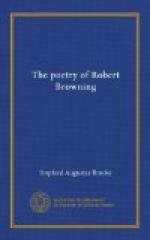If
I stoop
Into a dark tremendous sea
of cloud.
It is but for a time; I press
God’s lamp
Close to my breast; its splendour,
soon or late,
Will pierce the gloom:
I shall emerge one day.
You understand me? I
have said enough?
Aprile! Hand in hand with you, Aprile!”
And so he dies.
* * * * *
CHAPTER V
THE POET OF ART
The theory of human life which Browning conceived, and which I attempted in the last chapter to explain out of Pauline and Paracelsus, underlies the poems which have to do with the arts. Browning as the poet of Art is as fascinating a subject as Browning the poet of Nature; even more so, for he directed of set purpose a great deal of his poetry to the various arts, especially to music and painting. Nor has he neglected to write about his own art. The lover in Pauline is a poet. Paracelsus and Aprile have both touched that art. Sordello is a poet, and so are many others in the poems. Moreover, he treats continually of himself as a poet, and of the many criticisms on his work.
All through this work on the arts, the theory of which we have written appears continuously. It emerges fully in the close of Easter-Day. It is carefully wrought into poems like Abt Vogler and A Grammarian’s Funeral, in which the pursuit of grammar is conceived of as the pursuit of an art. It is introduced by the way in the midst of subjects belonging to the art of painting, as in Old Pictures in Florence and Andrea del Sarto. Finally, in those poems which represent in vivid colour and selected personalities special times and forms of art, the theory still appears, but momentarily, as a dryad might show her face in a wood to a poet passing by. I shall be obliged then to touch again and again on this theory of his in discussing Browning as the poet of the arts. This is a repetition which cannot be helped, but for which I request the pardon of my readers.
The subject of the arts, from the time when Caliban “fell to make something” to the re-birth of naturalism in Florence, from the earliest music and poetry to the latest, interested Browning profoundly; and he speaks of them, not as a critic from the outside, but out of the soul of them, as an artist. He is, for example, the only poet of the nineteenth century till we come to Rossetti, who has celebrated painting and sculpture by the art of poetry; and Rossetti did not link these arts to human life and character with as much force and penetration as Browning. Morris, when he wrote poetry, did not care to write about the other arts, their schools or history. He liked to describe in verse the beautiful things of the past, but not to argue on their how and why. Nor did he ever turn in on himself as artist, and ask how he wrote poetry or how he built up a pattern. What he did as artist was to make, and when he had made one thing to make another. He ran along like Pheidippides to his goal, without halting for one instant to consider the methods of his running. And all his life long this was his way.




